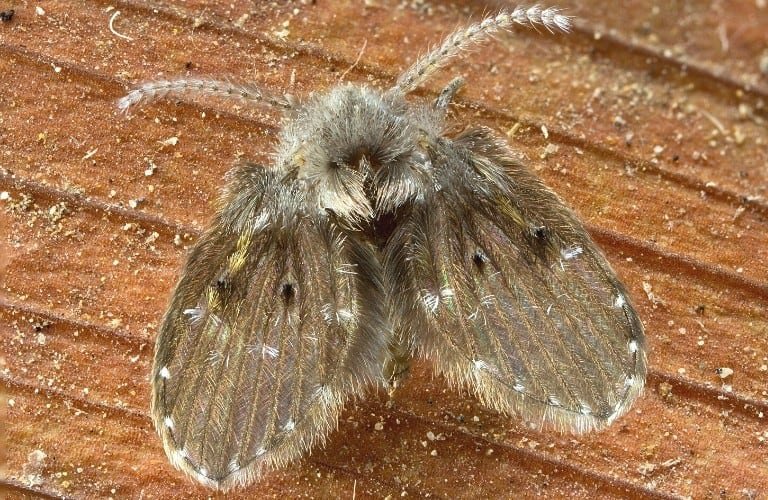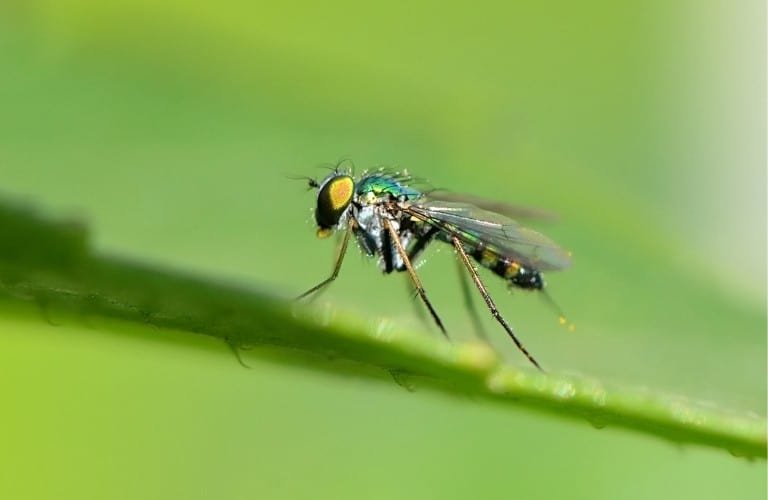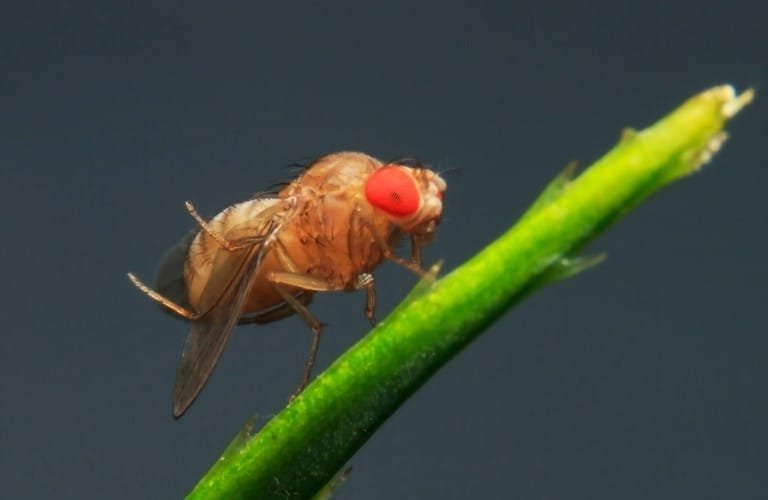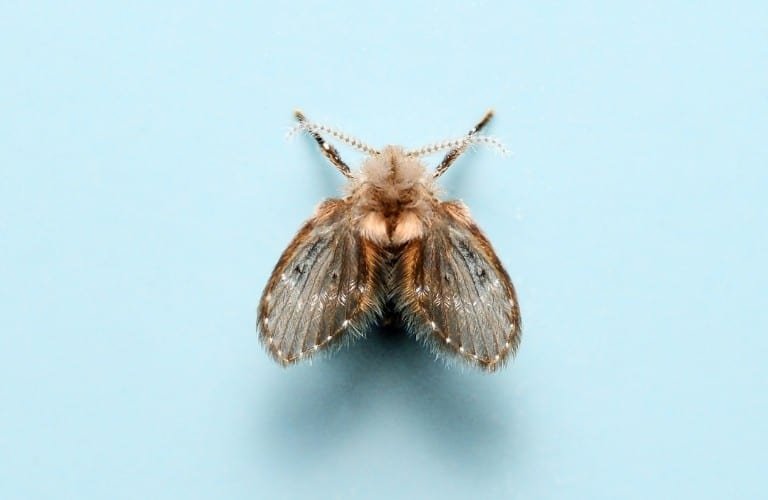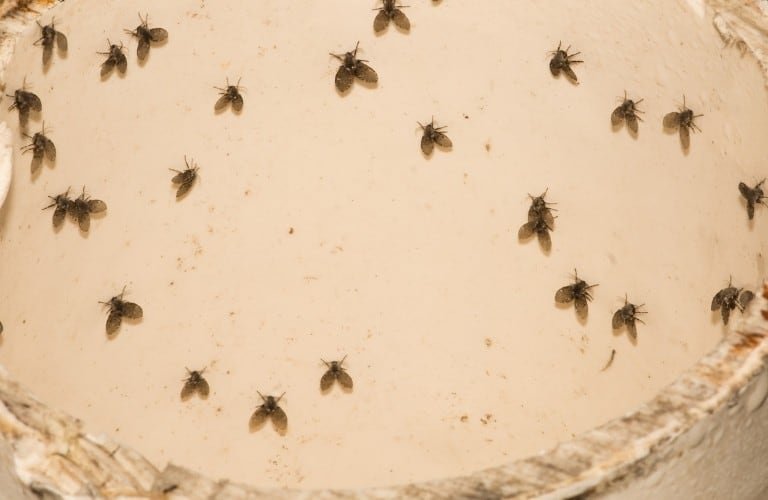If you’ve ever seen small bugs hanging out around a sink, shower, or bathtub, you’ve probably seen drain flies. These furry little bugs thrive in bathrooms and kitchens and any areas with lots of standing water and organic material.
What’s the best way to get rid of drain flies? To eliminate drain flies, you must kill the larvae as well as adults. Use UV light traps, glue traps, or bug zappers to target the adults. Clean your pipes and kill larvae with either a homemade solution, such as vinegar and baking soda, or a drain pesticide.
The good news is that drain flies are not very hardy and die easily. They should die quickly once measures are taken to eliminate them.
Knowing the correct elimination steps and the best products to get the job done will help you eradicate the problem quickly.
- Identification
- Removal Methods
- The Best Way to Get Rid of Drain Flies
- Basic Guidelines for Drain Fly Prevention
- Natural Solutions to Get Rid of Drain Flies
- Pesticide Solutions to Get Rid of Drain Flies
- Safety Precautions When Using Pesticides
- When to Call a Professional Exterminator
- Summary
- Frequently Asked Questions
Identification
Drain flies are also known as moth flies, sink flies, or sewer gnats. The more specific name for these bugs is Psychodidae.
Their average size is between 2 and 5 millimeters long, and their bodies are compact and hairy and typically gray or black in color with wide, oblong wings.
They join other small, flying insects, such as fungus gnats and fruit flies, to make up the group broadly known as “gnats.” Drain flies are commonly confused with fungus gnats and fruit flies.
The moniker “moth flies” comes from the fact that drain flies have disproportionately large wings. These wings are scaly, like the wings of moths. However, drain flies do not fly long distances, even with their large wings. One of the defining characteristics of drain flies is a short flight pattern that looks more like hopping than flying.
Behavior
Drain flies are most comfortable making their homes in standing water, particularly the water standing in the pipes of your home. This is because drain flies need high levels of moisture in order to survive. Plus, their diet consists entirely of organic matter, such as food remnants, animal or human feces, or garbage.
Because drain flies are so small, they do not need much food to survive. Small amounts of organic material are enough to feed a host of drain flies for months.
They prefer to lay their eggs on the slimy film on top of the drain water. Drain flies reproduce incredibly quickly and are able to produce up to 300 hatched larvae within 48 hours. This makes it incredibly difficult to handle an infestation because, by the time one adult is noticed, it has likely laid hundreds of eggs.
However, the life span of a drain fly is 24 days or less, so they die off fairly quickly. Psychodidae do not bite or sting but can be a nuisance if left uncontrolled.
Commonly Mistaken Pests
Fungus Gnats
Fungus gnats are tiny flying insects that are generally 1/4 inch long and are often found hovering near houseplants and around your head.
They are also attracted to moist, decaying organic matter, so compost bins and damp, dirty laundry will draw them in as well.
They can range in color from tan to brown to black and can cause serious damage to houseplants if left untreated.
(We have an entire section dedicated to gnats. Click here to learn more about these terribly annoying pests.)
Fruit Flies
Fruit flies, as their name implies, are often found near overripe fruit.
They are yellowish brown with large, red eyes, though distinctive features can be difficult to spot because they are so tiny.
Females are typically 2.5 millimeters long, and males are usually much smaller.
Do you know how to tell the difference between drain flies and fruit flies? We show you how here.
Removal Methods
| Method | Estimated Cost | Natural | Odor free |
| Drain Cleaner | $20 | Depends on product | Depends on product |
| UV light trap | $40 | ✅ | ✅ |
| Sticky Glue Traps | $10 | ✅ | Depends on product |
| Bug zappers | $30 | ✅ | ✅ |
| Drain Pesticides | $35 | Depends on product | Depends on product |
The Best Way to Get Rid of Drain Flies
Because drain flies are so prolific and reproduce so quickly, the most effective way to get rid of them is to use a two-fold approach to target both adults and larvae.
Use a UV light trap, like this stylishly designed model, to lure, trap, and kill adult drain flies.
Follow this step with an all-natural pesticide drain treatment, such as Natural Armor Fruit and Drain Fly Killer, to kill any eggs and larvae within the drains.
This dual plan of attack will break the life cycle so that you can focus on prevention techniques to ensure that the problem doesn’t reoccur.
Basic Guidelines for Drain Fly Prevention
Most types of gnats, including drain flies, fruit flies, fungus gnats, and no-see-ums, are attracted to the same things and are treated in similar ways.
In fact, most traps and pesticides work for all types of gnats.
The thing that makes drain flies unique from the rest is that they reproduce so quickly.
The best ways to prevent a drain fly invasion are to remove the things that attract them from your home, kill the larvae before they mature, and to use traps to kill the adults.
(We reviewed a ton of traps designed to target drain flies, and based on performance, we narrowed it down to the nine most effective. We share with you what we found to be the best traps here.)
Clean Out Drains
Drain flies typically hang out at the top of pipes near the drain. They still need oxygen to survive, so they cannot go too far away from the top opening.
So, if you can remove the drain cover of the sink, shower, or tub, you might be able to scrape away a significant amount of larvae.
You can recognize larvae by their pale (almost translucent) color and black head. They are flattened cylinders and have a natural adhesive that allows them to stick to pipes.
Use a paint scraper, knife, or other long utensil to reach as far as possible into the pipe.
If you can, get into the drain trap to reach more of the drain. The drain trap will likely contain a higher amount of larvae and adults, as this is where a significant amount of water stands.
Note: If your drain fly issues seem to be centered around your toilet, this will require a slightly different approach. Head over to this article for complete directions for this situation.
Clean Bathrooms and Kitchen
If you can keep your bathrooms and kitchen clean, you will remove food sources from drain flies.
Since drain flies eat decaying organic material, quickly clean those things up. Pay particular attention to garbage, rotting fruit, grease, human or animal feces, and dead skin.
Any place where you wash your hands or body has some amount of dead skin and sweat. These are natural foods for drain flies.
The more these things go unchecked in your bathroom or kitchen, the more likely you are to attract drain flies.
- Quickly seal and take out the garbage.
- Always run the garbage disposal as soon as you put food down it.
- Flush the toilet immediately after use.
- Use disinfectant to clean dirt out of sinks and showers.
- Store food in airtight containers (these are ideal).
Unclog Pipes
Standing water attracts drain flies. When drains are clogged and water cannot go down (or it goes down slowly), this provides the moisture and food drain flies need.
Use an unclogging drain cleaner, like this one, to remove blockages. These products are not pesticides and will not kill the flies or larvae, but they will help prevent standing water.
Dry Standing Water
If there are any leaky pipes in your kitchen or bathroom, be sure to clean the standing water quickly. Fix or seal the pipes to prevent further leaks.
Also be sure to dry floors, countertops, etc. whenever they become wet, like after a shower or doing the dishes.
If you happen to use a sump pump in your garage or basement, check it often for stagnant water, as drain flies can infest these machines too.
Learn how to thoroughly clean your sump pump to eliminate the drain flies’ breeding ground in this article.
Kill the Larvae
Larvae adhere to the sides of pipes very strongly. Simply running water through the pipes is not enough to flush away all of them.
Instead, try pouring half a gallon of boiling water down the drain. The extreme heat and steam will kill more larvae than room-temperature water.
There are also some homemade solutions you can try.
Dilute half a cup of white vinegar with water. The hotter the water, the more likely it is to kill more larvae.
The vinegar is powerful enough to kill larvae without damaging your pipes. Repeat this twice to ensure that all larvae have been killed.
Another concoction is to pour half of a cup of baking soda down the drain followed by a cup of vinegar. Let it sit overnight.
The baking soda and vinegar will react with each other, creating a fizzy foam that will coat the inside of the pipes.
In the morning, pour half of a gallon of water down the pipe to flush out the concoction and the (hopefully) dead larvae.
If boiling water and homemade products do not work, there are pesticide products available. These products get poured down the drain and coat the inside of the pipes, killing larvae along the way.
Kill the Adults
Adult drain flies are not very hardy, so they are easier to eliminate.
There are a variety of traps available for adult drain flies, some of which are homemade.
Put half of a cup of water in a bowl. Then add two tablespoons of apple cider vinegar, two tablespoons of sugar, and a couple of drops of dish soap to the bowl.
Leave this bowl near the problem area for a few days.
The sweet scent of sugar and vinegar will attract the drain flies. The dish soap will then make them too sticky to be able to fly, trapping them in the bowl.
Or, put an inch of apple cider vinegar in a bowl or cup. Cover the container with plastic wrap and punch a few holes in the plastic.
The vinegar will attract the drain flies. They will then fly in through the punched holes but will not be able to exit.
If these homemade solutions do not work, try purchasing a chemical pesticide. Find our recommendations below.
Natural Solutions to Get Rid of Drain Flies
There are several types of nonpesticide traps that will help take care of adult drain flies. Look through the details below to see which type is best for your situation.
| Preview | Product | Rating | |
|---|---|---|---|

|
Kensizer 10-Pack Fruit Fly Trap, Yellow Sticky... | Check Price on Amazon | |
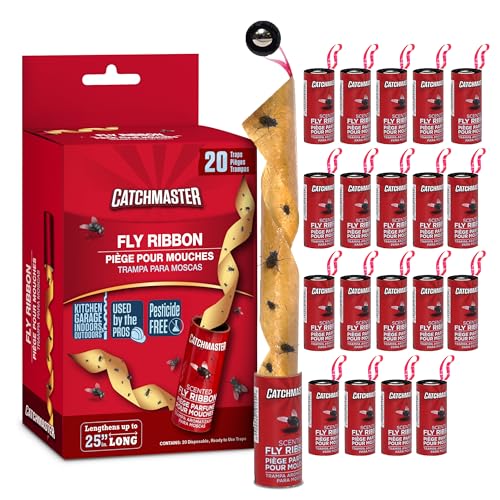
|
Catchmaster Fly Ribbon 20-Pack, Bug & Fruit Fly... | Check Price on Amazon |
UV Light Traps
UV light traps are electrical devices that use light to attract drain flies (and other bugs) to a sticky trap.
Drain flies and many other insects have phototaxis, which is a natural movement and attraction toward the light. UV light traps take advantage of this to lure them in.
Typically, these traps are shaped like a canister. Many contain gentle fans to suck the bugs into the canister when they come near enough.
Once inside the canister, the drain flies cannot fly back out of the entrance. They eventually land on the bottom of the canister, which is actually a sticky trap.
These sticky traps are made out of cardstock, cardboard, or PVC and must be replaced regularly.
Because they rely upon phototaxis, these traps work best during the night. It might take a couple of nights before you notice results.
KATCHY Indoor Insect and Flying Bug Traps are incredibly powerful, able to suck bugs in from two different directions.
The sticky glue traps at the bottom are not visible until you open the device to replace them and last for up to six months, longer than many other UV light traps.
This trap also has programmed options to automatically shut off after six or 12 hours, perfect for leaving on during the night.
They are available in either gray and fuchsia or black and blue.
Sticky Glue Traps
These traps use the same format of killing drain flies as the UV light trap, but they do not have a light or fan to attract the bugs.
Instead, many of these traps are yellow colored to mimic light and play on the bug’s phototaxis.
These are simple devices that do not require electricity or chemicals. They generally come with a string of some sort so that they can be hung from a nail or hanger.
Because of this, they are more cost effective than other types of traps.
A negative side of these yellow traps is that the dead bugs are not hidden, so they quickly become repulsive and unattractive.
Kensizer Dual-Sided Yellow Sticky Gnat Traps have incredibly sticky glue on both sides of the traps. They are cheap and simple, allowing the yellow color to attract all types of gnats.
Another form of sticky glue traps is a ribbon trap.
These are made of paper that has glue on both sides. The paper comes wrapped in a spiral inside a tube.
When you want to activate it, you pull the ribbon out of the tube and hang it in a window or from a cabinet.
Similar to other sticky glue traps, these can become unattractive very quickly. They are more suited for outdoor locations or bathrooms than kitchens.
Catchmaster Sticky Fly Tape Ribbon is scented to attract drain flies and other gnats. It is made out of durable paper and nontoxic glue and is easy to use.
Bug Zappers
A bug zapper use electricity and heat to kill bugs anytime they land on it. Just like UV light traps, zappers use light to attract drain flies and other bugs.
Some bug zappers are small and fit into wall outlets (like air fresheners), while others are large and cover lots of area.
These bigger zappers are perfect for places that have frequent drain fly and bug problems, like greenhouses, warehouses, or restaurants.
Some zappers produce a noise or odor each time they kill a bug, which is unattractive to some people.
Also, some zappers let the dead bugs fall all the way to the floor, leaving a mess. Look for a zapper that has a tray underneath the light to catch the bodies.
ASPECTEK Bug Zapper is a state-of-the-art zapper that covers over 6,000 square feet. It uses a strong UV light to draw in drain flies and other bugs.
It makes no noise and has a convenient tray at the bottom to catch dead bugs. It’s safe to use around children and pets thanks to the protective outer grate.
Pesticide Solutions to Get Rid of Drain Flies
If you were unable to eliminate the drain flies using natural methods, try using a drain pesticide.
| Preview | Product | Rating | |
|---|---|---|---|

|
Fruit Fly & Drain Fly Killer - Simple Commercial... | Check Price on Amazon | |

|
Rockwell - IBDC128 - InVade Bio Drain Gel -1... | Check Price on Amazon |
Drain Pesticide
Because of the need to kill eggs and larvae before they mature, it is important to pour pesticides into the drain.
Not all pesticides are safe to be poured into pipes, as they can damage the PVC. Look for a specific drain fly pesticide. These are thicker than most pesticides and coat the entire pipe as they run down.
Most drain pesticides are waterproof, so you can run the water quickly after application.
They are specially designed to kill larvae and adults on contact. When an adult tries to return to its home, it will land in the pesticide and be killed.
- Natural Armor Fruit and Drain Fly Killer is a long-lasting gel, protecting your pipes from infestations for months. It clings to pipes well and is incredibly powerful. All of the ingredients are nontoxic and safe for pipes.
- InVade Bio Drain Gel works similarly to other drain pesticides, but it contains probiotics that consume the organic material that is eaten by drain flies. Thus, it removes their source of food, making your pipes less attractive to them. It’s made from all-natural ingredients, so there’s no concern over the safety of your family, pipes, or septic system.
Safety Precautions When Using Pesticides
When using any type of chemical, it is important to follow closely the instructions on the container. This is the best way to protect yourself, kids, and pets.
Be sure to don the proper safety gear, such as gloves, long sleeves, goggles, and a face mask to protect yourself.
Also remember to wear shoes that cover your entire foot (no sandals, slippers, or flip-flops) for protection against accidental spills.
When to Call a Professional Exterminator
These solutions might take several attempts to completely eliminate the problem since drain flies have offspring so quickly.
If after several attempts the drain flies are still out of control, consider hiring a professional exterminator.
They will be able to determine the root of the problem and take care of it easily.
Summary
If you notice drain flies in your home, the best method of attack is to eliminate the larvae before they mature and to trap adults.
There are several homemade options that can be made out of normal household products. Or, purchase a drain pesticide that kills adults and larvae.
Remember, knowledge is a powerful weapon in any war waged, even if your opponent is only a few millimeters long.
Don’t miss out on important drain fly facts, key prevention methods, and elimination techniques that actually get results. To see all of our drain fly articles, click here.
Frequently Asked Questions
Does Drano Kill Drain Flies?
Given the strongly corrosive chemicals contained in Drano, both drain flies and their larvae will be killed by Drano applications. However, it’s not the pest solution available for the task. Drano will kill an infestation in the short-term, but it would be better to focus on drain fly prevention (following the tips above) and purchasing a pesticide designed for drain flies, like those recommended above. Both of these pesticides will cling to pipes for much longer than Drano, and will prevent the generation of new larvae.

